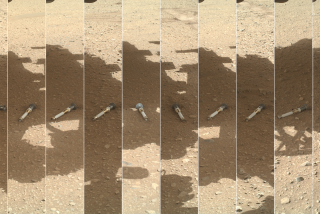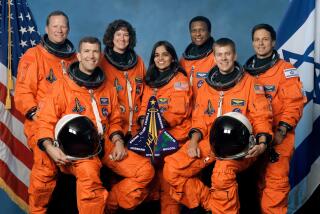Cost of Columbia Accident Inquiry Is Soaring
- Share via
HOUSTON — A vast army of as many as 10,000 investigators is trying to solve the puzzle of what destroyed the space shuttle Columbia, an effort that will cost as much as half a billion dollars, according to projections by government agencies involved in the inquiry and outside experts.
The estimated total would far exceed the roughly $175 million spent investigating the 1986 Challenger explosion, which involved a seven-month search-and-recovery mission in the Atlantic Ocean that cost $100 million by itself.
The investigative cost is separate from other financial fallout of the accident, including possible modifications to the orbiter fleet and institutional changes at NASA recommended by the Columbia Accident Investigation Board.
Accident investigations of all types have grown steadily more ambitious in recent decades, as the public and Congress have come to expect definitive answers to disasters, said Bernard Loeb, former head of aviation safety at the National Transportation Safety Board.
“Far more is expected today than 10 years ago,” Loeb said. “Once you have demonstrated what you can do, more is expected. There is an expectation that these investigations are going to go to the end of the world to determine what happened.”
No fixed budget has been set for the Columbia investigation, which is continuing under a White House declaration that authorized the massive effort shortly after the Feb. 1 crash. It includes a dizzying assortment of federal offices, ranging from the Environmental Protection Agency to the U.S. Forest Service.
“In terms of cost and breadth this is going to be the largest aircraft accident investigation ever,” said Michael Barr, director of University of Southern California’s aviation safety program. “I just can’t think of anything that will compare. It’s just mind-boggling.”
The costliest airplane accident investigation involved TWA Flight 800, in which a 747 exploded after takeoff from New York in 1996, said Ted Lopatkiewicz, a spokesman for the National Transportation Safety Board. The official cost of that inquiry was $35 million, not including FBI efforts that ruled out terrorism as the cause.
Beyond the heightened public expectations, the Columbia investigation is driven by another imperative: NASA cannot afford to lose another space shuttle without shutting down the human spaceflight program for as much as a decade.
The space agency needs all three of its orbiters to support the international space station. Thus, when it returns to flight, NASA must have far greater confidence in the reliability of the system than at any time since flights began in 1981.
“To the public, the astronauts are still heroes,” Loeb said. “It is important to this country. And there are questions about whether we should have manned versus unmanned spaceflight. Therefore, there is a need to determine what happened.”
To make that determination, the Columbia Accident Investigation Board, the formal group appointed to determine the cause, has said it is “leaving no stone unturned.” It is reviewing millions of pages of documents, sending members to manufacturing plants and government laboratories all over the country, and ordering a range of laboratory tests. It is also holding a series of public hearings to take testimony and gather evidence.
The board has not given an overall cost estimate or a timetable for its investigation, said spokeswoman Laura Brown. In many conversations that retired Adm. Harold W. Gehman Jr., who is heading the investigation, has had with members of Congress, they have expressed support for the board’s efforts, Brown said.
“The admiral is very conscious of cost issues,” Brown added.
The board is operating with $10 million from a $50-million appropriation by Congress after the Feb. 1 accident. The other $40 million is being held by NASA to cover its costs. The money, however, is not paying for the salaries of government employees assigned to the investigation. The board includes a number of high-ranking military officers and civil service employees, whose salaries are borne by their own services.
As the investigation pushes forward, the federal government must bear the expense of maintaining the program, with its nationwide workforce of 17,000, while the shuttle remains grounded -- a tab that could run as much as $10 million per day. Many of those employees are continuing their normal activities that involve maintaining the orbiters and preparing for future missions, said NASA spokesman James Hartsfield.
The total cost also does not include potentially expensive modifications to the space shuttle and institutional changes at NASA that may result from the board’s recommendations. Nor does it include the loss of the orbiter itself, which originally cost about $2 billion to manufacture nearly 25 years ago.
NASA is already setting into motion efforts to improve the external tank’s spray-foam insulation, which broke off on launch and may have damaged the orbiter.
It is also studying the feasibility of inspecting and repairing damaged thermal protection tiles in orbit. And it wants to improve its photographic capability on launches to monitor for debris damage. Those programs alone could cost hundreds of millions of dollars, if not more, experts say.
The board is not itself conducting the bulk of the investigative work.
The Federal Emergency Management Agency is taking the lead in the hunt for debris, which will continue undiminished through the end of April, according to Scott Wells, the coordinator of the effort. Wells said the search and recovery of debris alone is expected to cost $302 million, about triple the amount spent on the Challenger search.
The agency is operating four base camps in Texas, each with 1,000 paid employees who are spending each day conducting searches on foot and spending nights camped in tents. Most of the workers are part of a firefighting effort organized by the U.S. Forest Service and various state agencies.
Wells said the plan is to search by foot a corridor 240 miles long and four miles wide along the center line of the shuttle’s flight path. Standing 10 feet apart, the investigators are walking and visually searching about 1,000 square miles of Texas.
About three dozen aircraft are searching an additional 1,500 square miles a few miles farther from the center line of the flight path. And divers are searching lake bottoms for dozens of pieces of debris identified by Navy sonar experts. So far, the hunt has located 28,000 pieces of wreckage.
The EPA has dispatched 700 staffers to help deal with any hazardous materials, which include the toxic fuels Columbia carried in its various thruster and rocket systems.
Boeing Co., which built the shuttle and provides engineering services for it, has roughly 1,000 employees detailed to the investigation, assisting with aerodynamics analysis and debris location, according to spokesman Dan Beck. “Wherever there is expertise needed by the [investigation board] or NASA, we are providing it,” he said.
USA, the private contractor that prepares the shuttles for launches and assists with almost all aspects of flights, has 300 employees assigned to the investigation and others that have provided temporary help, said company spokesman Michael Curie. USA has about 10,300 workers, though some of the employees assist with other programs such as the international space station.
Lockheed Martin Corp. has extensive efforts underway to assist the investigation, said company spokesman Jeff Adams. Employees in Mississippi, multiple locations in Texas, Louisiana and New Jersey are spending all or part of their time on the investigation, Adams said, though he could not provide an exact number.
Lockheed has 1,800 employees at its Michaud, Miss., plant where the shuttle’s external tank was produced. The Columbia board has stopped certain operations at the plant and impounded a $43-million external tank for various tests. NASA officials said they did not know how many of the roughly 1,700 shuttle employees are involved in the accident investigation.
Based on statements given by NASA officials since the crash, it would appear that hundreds of the agency’s employees are involved in the inquiry at Johnson Space Center, Kennedy Space Center, Langley Flight Research Center, Ames Research Center and other NASA facilities.
Barr, the USC expert who has taught aviation investigators for 18 years, said he would be surprised if the cost remains under half a billion dollars. Included in this estimate would be FEMA’s $302 million, the $50-million congressional appropriation and roughly $150 million in government and private contractor costs for employees involved in the investigation.
In the end, the Challenger disaster cost NASA an estimated $15 billion, according to the American Institute of Aeronautics and Astronautics. In addition to the costs of the investigation, the figure includes $2 billion spent on building a replacement, restructuring the agency’s organization, research delays from the entire fleet being grounded for nearly three years, and safety upgrades made to the fleet.
“Because of public opinion you have to keep going until you find the cause. You just can’t write it off,” Barr said. “It has to do with our national pride. We want to find out what happened so it would never happen again, and if somebody screwed up we want justice for it.”
More to Read
Sign up for Essential California
The most important California stories and recommendations in your inbox every morning.
You may occasionally receive promotional content from the Los Angeles Times.














